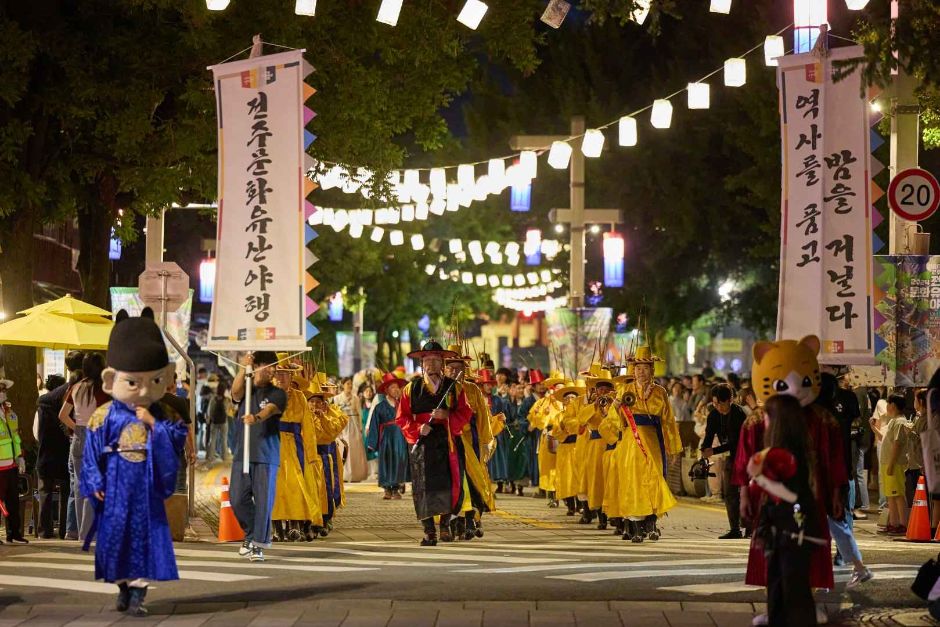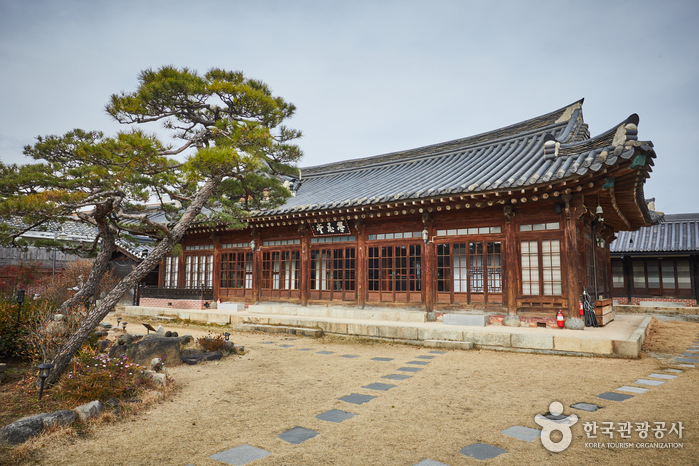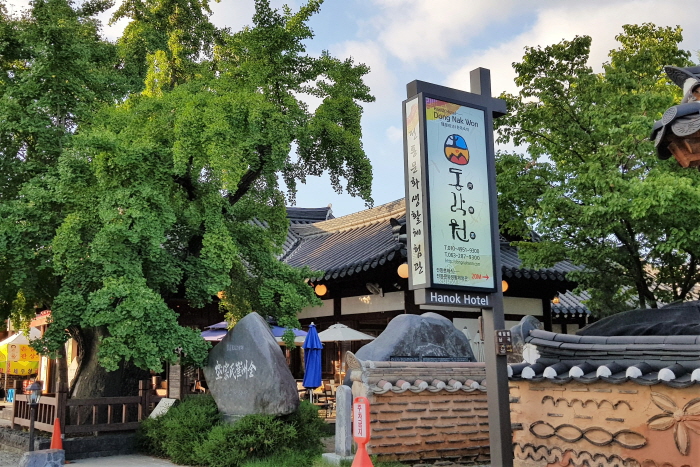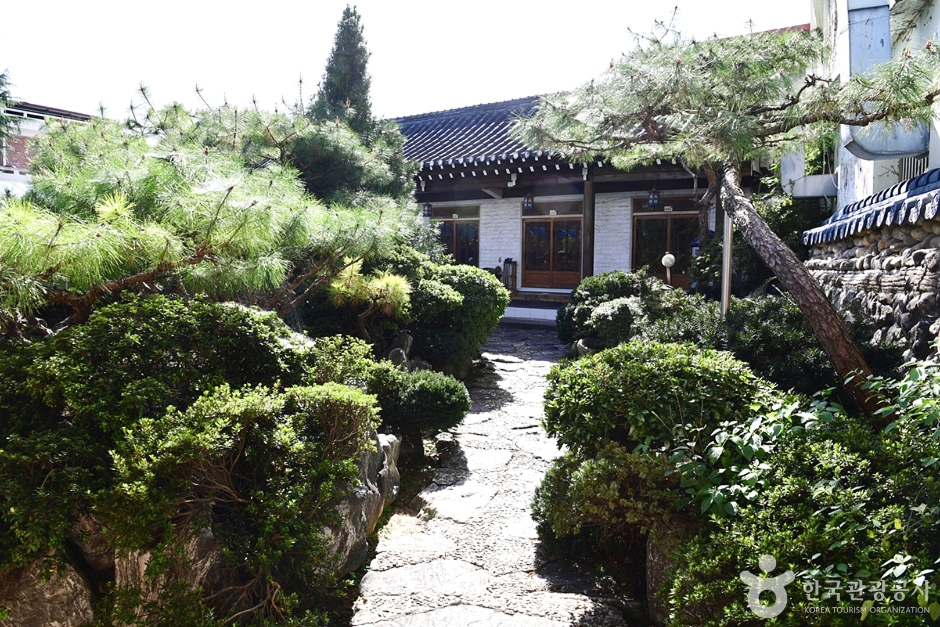Paseo Nocturno de Patrimonios Nacionales en Jeonju (전주국가유산야행)
420.2M 2025-09-03
Taejo-ro 44, Wansan-gu, Jeonju-si, Jeonbuk-do.
063-232-9937
Este tour se dedica a la preservación y puesta en valor del patrimonio cultural coreano. Jeonju es una ciudad que alberga gran cantidad de sitios que son patrimonio histórico de la época de Joseon. Durante las noches que dura el tour, los visitantes pueden experimentar y conocer de cerca la historia de Corea y apreciar su legado ancestral.
Jeonju Waengi Kongmulgukbap Specialty Restaurant (전주 왱이콩나물국밥전문점)
481.0M 2025-07-14
88, Dongmun-gil, Wansan-gu, Jeonju-si, Jeonbuk-do
Hakindang (학인당)
499.4M 2025-07-18
45, Hyanggyo-gil, Wansan-gu, Jeonju-si, Jeonbuk-do
Dong Nak Won / 동락원
500.8M 2025-03-05
33-6, Eunhaeng-ro, Wansan-gu, Jeonju-si, Jeonbuk-do
+82-63-287-9300
Hanok Hotel Dongrakwon used to be a memorial hall for Missionary M. Junkin who worked in Jeonju in 1985, and had long been used as an official residence for the Bank of Korea. The 100-year-old Hanok retains the history and culture that modern hotels do not have. Since the renovation to make it a hanok hotel, it is now utilized as a space for traditional music performances, traditional weddings, or small weddings. The entire building can be rented for various gatherings, seminars, conferences, family events, and so on. The beauty of a hanok is found in every corner of Dongrakwon such as the wide lawn, the pond in front of Sarangchae, and the jar stand next to Anchae. The antique furniture and folding screen in the rooms have been used for generations, enabling guests of the hanok to time travel to 50-100 years ago.
The yard is a great place to play simple Korean traditional plays such as Jegichagi and Dakjichiji, whereas the free-of-charge red clay sauna will relieve fatigue. The outdoor hot / cold bath and sun bath site is a new addition to Dongrakwon.
There is a 600-year-old Ginkgo tree standing on the Eunhang-ro, where the accommodation is located. Opposite the alley is Donghak Revolution Memorial Exhibition Hall; Gyeonggijeon East Gate is 200m away. The hotel is close to Taejo-ro, the busiest street of Jeonju Hanok Village; neighboring Eunhang-ro, Choi Myeong Hee-gil, and Eojin-gil all retain the unique quietness and beauty of Hanok Village. It will be also nice to ride on the mountain bike that Dongrakwon offers free of charge in order for guests to visit corners of the Hanok Village, or ride along the Jeonjucheon Stream.
Hankookjib (한국집)
512.6M 2025-07-09
119, Eojin-gil, Wansan-gu, Jeonju-si, Jeonbuk-do
Hankookjib literally means 'Korean house.' The restaurant serves Jeonju bibimbap, kongnamul haejangguk (spicy bean sprout soup), sagol gomtang (thick beef bone soup), doenjang jjigae (soybean paste stew), and samgyetang (ginseng chicken soup). Many well-known figures, including former presidents of Korea, have been sited as enjoying the authentic Jeonju bibimbap here.
Catedral Católica de Jeon-dong en Jeonju (전주전동성당)
538.0M 2024-10-15
Taejo-ro 51, Wansan-gu, Jeonju-si, Jeonbuk-do.
La Catedral Católica de Jeon-dong fue construida en 1914 al estilo occidental y fue designada como Sitio Histórico. Es la estructura del estilo occidental más grande de las provincias de Jeollanam-do y Jeollabuk-do. La catedral es elegante con sus paredes de ladrillos y lo más encantador es la entrada y la torre de campana. La entrada de la iglesia tiene una forma arqueada que le da un toque bizantino, mientras que la pequeña torre de campana ubicada en el centro agrega una belleza singular. Desafortunadamente, algunas partes de la catedral fueron destruidas por un incendio en 1988.
Escuela Confuciana Jeonju Hyanggyo (전주향교)
539.7M 2025-07-09
Hyanggyo-gil 139, Wansan-gu, Jeonju-si, Jeonbuk-do.
Es una escuela confuciana que fue fundada en la dinastía de Joseon (1392-1910) y fue designada como Tesoro Histórico. Fue un establecimiento educativo del período de Joseon que estuvo originariamente ubicado en el sitio del santuario Gyeonggijeon, pero fue relocalizado en este lugar en 1603. Las tablillas mortuorias de 7 eruditos confucianos chinos y los 18 eruditos coreanos están conservadas en el edificio principal llamado Daeseongjeon.
Puerta Pungnammun de Jeonju (전주 풍남문)
553.3M 2024-04-07
Pungnammun 3-gil 1, Wansan-gu, Jeonju-si, Jeonbuk-do.
La puerta Pungnammun se ubica donde estaba la puerta sur de la antigua Fortaleza de Jeonju. Sus primeras construcciones datan de los años 1734 y 1768, y tras ser parcialmente desmantelada por tareas de planificación urbana, finalmente recuperó su forma original en 1978.
Museo de Caligrafía Gangam (강암서예관)
571.1M 2024-04-07
Jeonjucheondong-ro 74, Wansan-gu, Jeonju-si, Jeonbuk-do.
Jeonju es considerada como una de las ciudades de la cultura y el arte de Corea, pero si desea sentir su ambiente artístico más de cerca y profundamente, visite el museo de caligrafía Gangam, situado en los alrededores de la Aldea Tradicional. El museo fue inaugurado en el año 1995 y es visitado por una gran cantidad de personas que aman el arte. En sus cercanías se encuentran varios lugares turísticos, considerados como valiosos patrimonios del país, la puerta Pungnammun, el santuario Gyeonggijeon, y hacia el este, la Escuela Confuciana Jeonju Hyanggyo, junto con el monte Omokdae, etc.
Este museo fue fundado en conmemoración y homenaje al gran maestro Song Seong-yong, cuyo seudónimo era “Gangam”, quien fue un famoso calígrafo nacido en esta región. Siendo el único museo exclusivo de la caligrafía en el país, expone un total de 1.162 piezas artísticas de las siguientes figuras claves del ramo: Chusa Kim Jeong-hui, funcionario público y calígrafo de Joseon, Lee Sam-man (seudónimo Changam), Kim Hong-do (seudónimo Danwon), Jeong Yak-yong (seudónimo Dasan), famoso filósofo religioso de Joseon, etc.
Por otro lado, a 200 m de distancia de este museo se inauguró la Sala Conmemorativa de la Revolución Donghak, por lo tanto, también podrá aprovechar la ocasión para conocer la historia de esta revuelta campesina.
Hanok Garden in Jeonju (전주한옥마당)
572.5M 2025-10-23
80-13, Jeonjucheondong-ro, Wansan-gu, Jeonju-si, Jeonbuk-do
Jeonju Hanok Madang is located in the Jeonju Hanok Village. Jeonjucheon Stream and Namcheongyo Bridge are only one block away, whereas Gangam Calligraphy Museum, Jeonjuhyangyo Confucian School, Jeonju Hanbyuk Culture Center, Nambu Market, and Markbu Market Youth Mall are nearby. Major attractions of the Jeonju Hanok Village such as Gyeonggijeon, Jeondong Catholic Cathdral, and Omokdae are also within walking distance.
The main building and servants’ quarters of Jeonju Hanok Madang were built in 1941. It was renovated to retain the original shape of the traditional hanok, yet cozy and comfortable enough for modern people to use. Porches are attached to every room while Faith Room and Hope Room have additional inner floors attached to it. Inside the rooms are rafters, beams, wooden pillars walled with Hanji wallpapers, and ribs of lattice doors. There is a clean bathroom in each room.
The yard is the place the owner couple cherishes the most. Guests can enjoy the yard in any room just by opening the door. It is a combination of jar stands, a small pine tree, and small potted plants. Different flowers bloom from spring through autumn. It is such a pleasure to sit on the porch and appreciate the scene. In autumn, the persimmon tree bears fruits and dried persimmons hang from the eaves.










 Español
Español
 한국어
한국어 English
English 日本語
日本語 中文(简体)
中文(简体) Deutsch
Deutsch Français
Français Русский
Русский